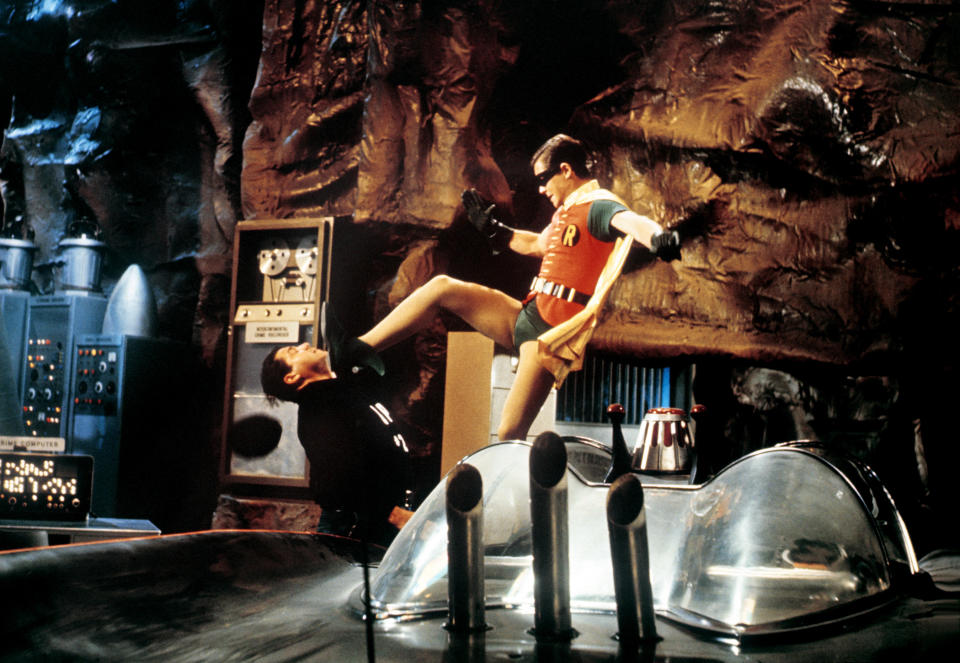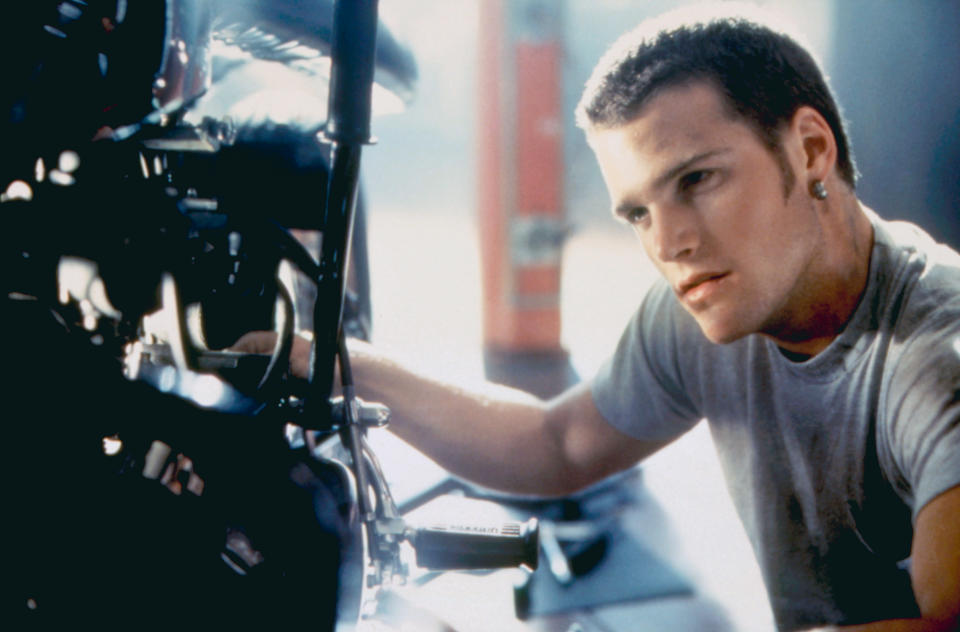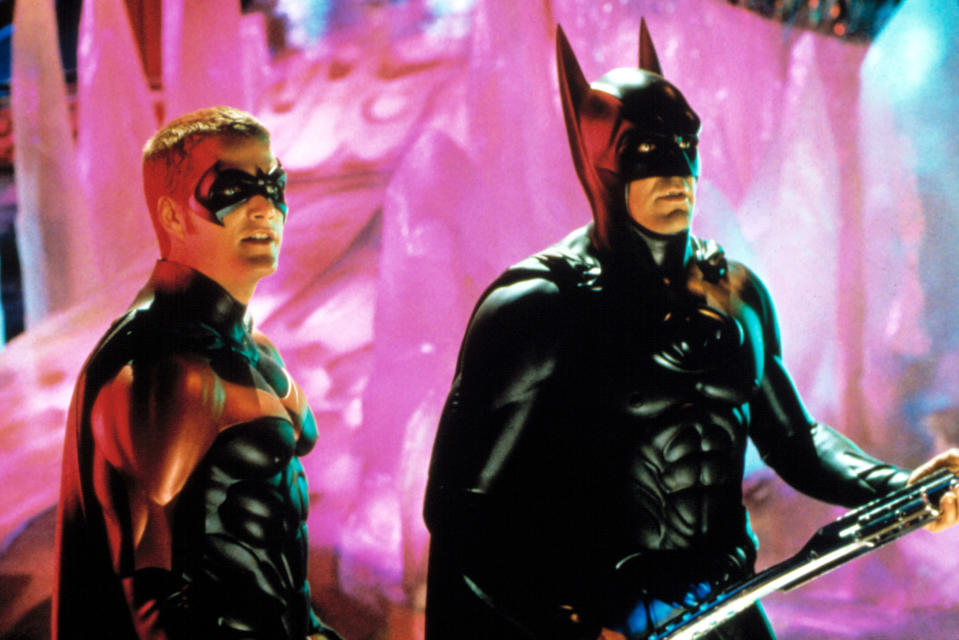What the [bleep], Batman: How the 'Titans' version of Robin got to be so dark
The new superhero series, Titans — which launches on the DC Universe app Friday — stars the younger half of the Dynamic Duo as the leader of a Batman-free super-group that includes Raven, Starfire, and Beast Boy. But this version of Robin the Boy Wonder definitely isn’t the “laughing, fighting young daredevil” who has been battling bad guys alongside the Caped Crusader for nearly 80 years. That’s established in the show’s first big action sequence, when an older, meaner Robin (played by Brenton Thwaites) drops in on an alleyway full of miscreants and proceeds to beat them senseless. “Where’s Batman?” one of the unlucky criminals asks. “F*** Batman,” the Dark Knight’s former kid sidekick replies, a phrase that has become meme worthy since debuting at San Diego Comic-Con this summer.
Those words are like an R-shaped dagger in the heart to serious Robin fans, myself included. As a kid, the Boy Wonder was the reason I got into comics, and I’m always eager to see the character translated into the live-action realm, even if I’m routinely disappointed by his portrayal. But here’s the thing: Titans isn’t an anomaly. Instead, the series represents the culmination of a character evolution that has played out across multiple live-action movies and TV shows. In cartoons and comic books, we’ve been treated to a wide range of Robins, from Jason Todd and Damian Wayne to Carrie Kelly and Stephanie Brown. (For the record, the mid-’90s Tim Drake incarnation remains my all-time favorite costumed hero.) But the live-action realm has so far been limited to the original Robin, Dick Grayson, and he’s only gone in one direction: from Boy Wonder to Brooding Wonder. (Watch the video above to see our take on Robin’s live-action evolution.)
Let’s fire up the Bat Computer for a quick history lesson. Co-created by Bob Kane, Bill Finger, and Jerry Robinson, Robin made his comic book debut in 1940 as part of as part of a concentrated effort to transform Batman into a kinder, gentler vigilante. Like his eventual guardian Bruce Wayne, Dick Grayson, has a tragic history — acrobat parents who perish midperformance in an act of high-wire sabotage — but he notably doesn’t let that tragedy consume him. And that’s always been the secret of Robin’s appeal to young readers. With his bright red-and-yellow outfit and exuberant attitude, the Boy Wonder embodies the youthful glee of putting on a costume and fighting crime with little of the adult angst. You know the saying, “Always be Batman?” Given Bruce’s emotional baggage, I always thought it would be a heck of a lot more fun being Robin.

Douglas Croft tapped into the character’s exuberance for his spirited portrayal of Robin in the 1943 serial, Batman — the first time that the Dynamic Duo made the leap to live action. The actor was 16 at the time, and to this day he remains the youngest person cast in the role. That’s significant because the comic book character is defined by his youth, but the actors playing him onscreen have largely been too old to believably be called “Boy Wonders.” Part of the reason why Robin is frequently aged up in movies and TV shows is purely practical: It helps the filmmakers navigate around the legally mandated production rules that protect child and teen actors. But it’s also an acknowledgement of a reality that Kane and his collaborators never questioned in their comics, and I admittedly never thought much about as a kid either: whether it’s heroic to knowingly put a child in harm’s way.
The practice of casting older actors as Robin started with Johnny Duncan, who replaced Croft in the 1949 sequel serial, Batman and Robin. At 26, Duncan was a full decade older than his predecessor, and it shows in his comparatively stiff portrayal. Duncan’s lack of pep renders Robin a more standard-issue sidekick; he’s there to support Batman rather than provide any sort of character contrast. In that way, Batman and Robin is an effective portrayal of the Dynamic Duo as a team, but at the sacrifice of Robin’s individual personality.

You can’t argue that the next Boy Wonder, Burt Ward, suffers from a lack of personality. The 20-year-old co-star of the classic 1966 Batman TV series and its feature film has the physicality of an adult, but the enthusiasm of a 10-year-old, as typified by his signature catch phrase. And where the cheaply made serials settled for black and white, the Batman TV show is fondly remembered for its in vivid colors, allowing the costume designers to craft a Robin suit that could have leapt directly off the comic book page and onto the screen. Ward’s performance might seem goofy today, but that costume, combined with the actor’s stalwart bravado, makes him the definitive live-action portrayal of the Golden Age Robin that Kane and his collaborators created.
At the same time, the Batman series also represents the end of the line for that version of the character. As the ’60s gave way to the ’70s, a new creative regime at DC Comics sought to return Batman to his roots as a “weird figure of the night.” That meant bringing a darker tone to Robin as well; in short order, Dick Grayson grew up and left the Batcave for college, where he largely operated on his own or with the Teen Titans. By the mid-’80s, Dick Grayson became his own hero — Nightwing, complete with his own Batman-like costume — and the mantle of Robin passed to Jason Todd, an orphan with a dark past and serious anger issues that led readers to vote to send him to an early grave in one of the comic book industry’s most controversial stunts.
Meanwhile, the Dark Knight incarnation of Batman had been popularized in popular culture by the combination of Frank Miller’s 1986 graphic novel The Dark Knight Returns and Tim Burton’s 1989 summer blockbuster, Batman. Singularly obsessed with his one-man war on crime, Burton’s Batman had no room in his Batcave for a Boy Wonder, although Marlon Wayans has since revealed he was supposed to play a wildly reinvented version of Robin in the 1992 sequel, Batman Returns.

After complaints that his second installment took the Dark Knight in a direction that was too weird, Burton bailed on helming the next installment, 1995’s Batman Forever, and Joel Schumacher was tasked with bringing some fun back to the Bat franchise. That meant bringing back Dick Grayson, played by a 24-year-old Chris O’Donnell. But in keeping with the times, not to mention the dark tone of the movies, this Dick Grayson had a Jason Todd-like petulant streak. Where Robin used to be the one who lightened Batman’s mood, this Batman has to talk Robin out of going full Death Wish on the man who killed his parents, Tommy Lee Jones’s Two-Face.
Robin’s newfound moodiness is reflected in his muted costume; squint really hard through the movie’s neon-infused gloom and you may catch a glimpse of those classic red, yellow, and green hues. (It’s telling that O’Donnell’s best moment in the movie finds him channeling Burt Ward.) Schumacher’s follow-up, 1997’s Batman & Robin, is frequently reviled for being even campier than the ’60s TV series, but if you’re able to look past the headache-inducing visuals and awful ice puns, you’ll see that O’Donnell’s Robin is still kind of a grumpy jerk. Besides spending much of the movie whining to Batman about not being taken seriously as a partner, Dick also acts like a creep around Batgirl and Poison Ivy, and repeatedly proves himself more of a hindrance than a help in supervillain fights.

Batman & Robin not only ruined Robin’s reputation — it killed the Batman movie franchise for nearly a decade. And when Christopher Nolan revived the series with 2005’s Batman Begins, he deliberately left the Boy Wonder on the bench until his third installment, 2012’s The Dark Knight Rises. But even then, the celebrated auteur struggled with how to pair the character (played by Joseph Gordon-Levitt) with the grittier Batman that moviegoers seem to prefer, going so far as to strip him of his costume and his name. In the film, Gordon-Levitt introduces himself as John Blake, rather than Dick Grayson, and it’s not until the very end that we learn his true identity.
At 31, Gordon-Levitt was the oldest Robin to date, and the actor plays the role with a world-weariness that complemented his age. But Blake does fulfill one crucial function in keeping with the younger Robin’s: He’s Batman’s conscious — the person urging him to move past his inner darkness and rise to the occasion of being a hero. Not for nothing, but his age also makes him to be the first live-action Robin to inherit the mantle of the Batman, something that’s happened more frequently in the comic books.

Director Zack Snyder decided that the Boy Wonder was of more value dead than alive in 2016’s Batman v Superman: Dawn of Justice. The only trace of Robin in the movie is a costume that sits among Batman’s collection of artifacts, tagged with a taunting message from the Joker that hints at a tragic fate. It’s one of Snyder’s many references to The Dark Knight Returns, as well as a convenient way to sidestep having to find a place for Robin in his dark, depressing version of the DC Universe. Let’s not forget, this is also the movie that needlessly kills off Superman’s younger pal, Jimmy Olsen, in its opening moments.
This brings us up to present day, and the Titans version of Robin, who would feel right at home in Dawn of Justice. DC Universe’s flagship series takes gleeful delight in showcasing Grayson’s R-rated behavior, whether it’s his brutal fighting style, raging libido, or explicit language. It’s as if the producers assumed that years of watching the Dark Knight on the big screen had made fans equally eager to see a full-on Dark Robin.
To be fair, there is a context in which the show’s take on the character makes sense: If a child grows up in the company of a tortured guardian who channels his grief into punching bad guys, that kid is naturally going to have serious issues as an adult. The grown-up Grayson has expressed anger and resentment toward his mentor in the Batman comics over the years. And Thwaites is the first Robin since Croft to convincingly embody the action-hero aspect of the character; Ward’s fighting style could generously be described as chaotic, while O’Donnell’s main expertise seemed to be breaking all of Batman’s fancy toys.

Still, it’s disappointing that Robin’s biggest live-action showcase to date leans so heavily into his anger. The Boy Wonder was created to be the splash of color that cuts through the Dark Knight’s gloomy existence. By cloaking him so heavily in darkness, Titans reduces the character to little more than a mini-Batman, which was never his creators’ intention. The good news is that Titans has already been renewed for Season 2, so there’s a chance that either Dick Grayson or Jason Todd (who will make his live-action debut later in the first season) will grow into being the best Boy Wonders they can be.
Titans is currently streaming on the DC Universe app. Watch the R-rated trailer:
Read more from Yahoo Entertainment:

